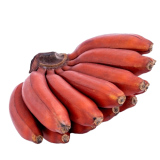Banana
“UNPEEL JOY: GO BANANAS FOR NATURE’S ENERGY BOOST!”
Nutritional Content of Bananas (per 100g)
Calories
89
Sugars
12.2g
Carbohydrates
22.8g
Protein
1.1g
Fiber
2.6g
Fat
0.3g
Vitamin A
1% of the daily recommended intake
Potassium
358mg (about 10% of the daily recommended intake)
Vitamin C
14% of the daily recommended intake
Health Benefits of Banana
Rich in Nutrients
Bananas are a good source of essential nutrients, including vitamin C, potassium, vitamin B6, and dietary fiber.
Heart Health
The high potassium content in bananas helps maintain healthy blood pressure and reduces the risk of stroke.
Digestive Health
Bananas are rich in dietary fiber, which aids in digestion and helps prevent constipation.
Energy Boost
The natural sugars in bananas, including glucose, fructose, and sucrose, provide a quick and sustained energy boost.
Good for Skin
Vitamin C in bananas promotes healthy and glowing skin by aiding collagen production.
Rich in Antioxidants
Bananas contain several antioxidants, including dopamine and catechins, which help reduce the risk of chronic diseases.
Supports Weight Loss
The fiber in bananas helps control appetite and promotes a feeling of fullness, making them a good choice for weight management.
Nature's Energy Booster!
Recommended Daily Intake
There’s no specific daily intake of bananas, but consuming one or two medium-sized bananas a day is generally considered healthy. However, it’s essential to balance banana consumption with other fruits and vegetables to ensure a varied diet.
Best Time to Eat Bananas
Bananas can be enjoyed at any time of the day. They make a convenient and portable snack, can be added to breakfast cereals or smoothies, and are commonly used in desserts and baked goods.
How Bananas Grow
Bananas grow on large, herbaceous plants called banana plants. Contrary to popular belief, banana plants are not trees; they are giant herbs. The banana plant produces a flower spike that bears clusters of bananas. Once the bananas are harvested, the plant dies back, but new shoots emerge from the underground rhizome to produce more fruit.
Places Where Bananas are Grown
Bananas are grown in many tropical and subtropical regions worldwide. Some of the largest banana-producing countries include India, China, the Philippines, Ecuador, and Costa Rica. In India, bananas are cultivated in states like Maharashtra, Gujarat, Tamil Nadu, and Karnataka.
Types and Varieties
There are various types and varieties of bananas, but the most common type consumed globally is the sweet banana, often referred to as the dessert banana. Bananas are a versatile and nutritious fruit enjoyed by people of all ages. They are not only delicious but also provide a range of health benefits, making them a popular choice for a healthy diet. Varieties are vary in taste, texture, and culinary uses, catering to different preferences and cuisines.
Cavendish
The most common variety, known for its sweet taste and yellow skin.
Plantain
Larger and less sweet, primarily used for cooking in many tropical regions.
Red Banana
Smaller and sweeter than the Cavendish, with red or purple skin.
Baby Banana
Small, sweet, and often eaten as a snack.



















 Mango
Mango Banana
Banana Pomegranate
Pomegranate Guava
Guava Papaya
Papaya Apple
Apple Orange
Orange Kiwi
Kiwi Strawberry
Strawberry Grapes
Grapes Watermelon
Watermelon Sapota
Sapota Amla
Amla Pineapple
Pineapple Coconut
Coconut Spinach
Spinach Broccoli
Broccoli Tomatoes
Tomatoes Carrots
Carrots Cabbage
Cabbage Bell Peppers
Bell Peppers Cauliflower
Cauliflower Bitter Gourd
Bitter Gourd Eggplant
Eggplant Okra
Okra Green Peas
Green Peas Onions
Onions Garlic
Garlic Pumpkin
Pumpkin